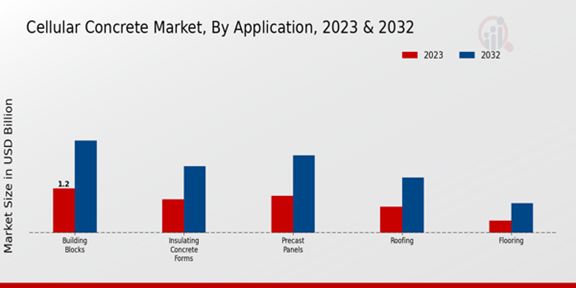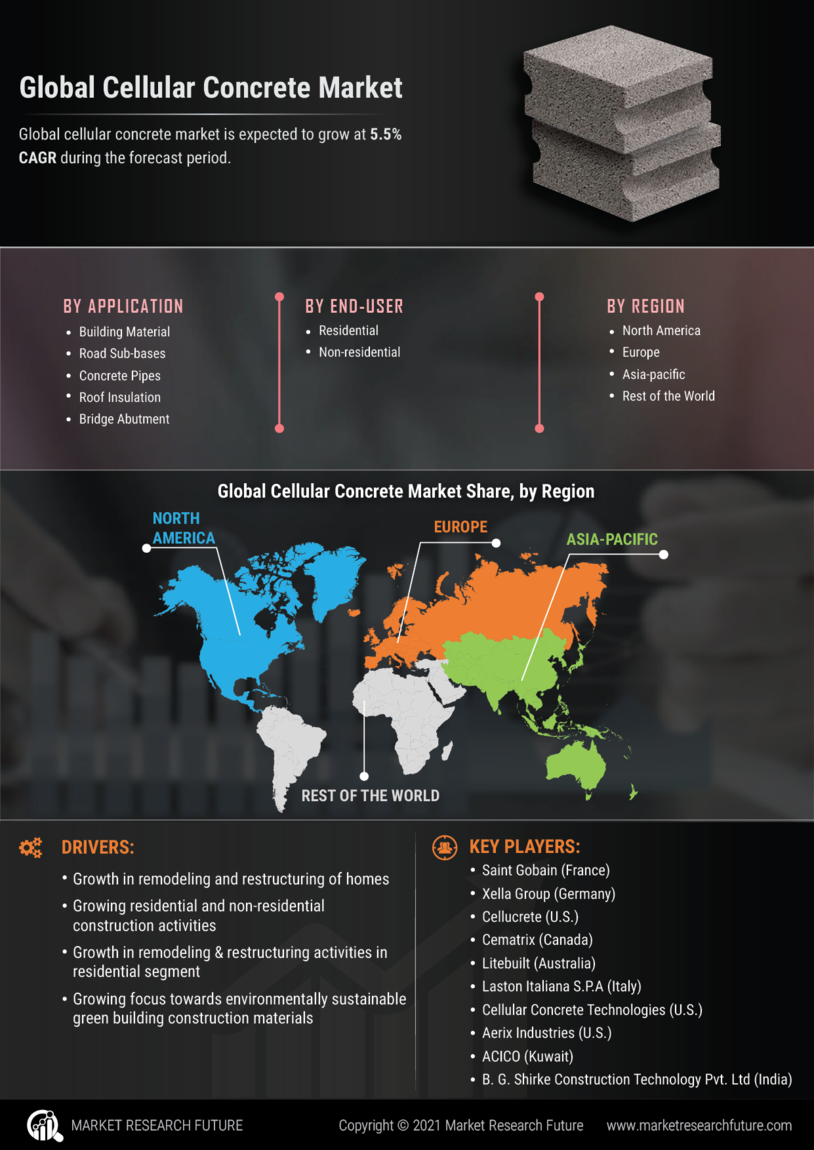Cellular Concrete Market Application Insights
The Cellular Concrete Market is expected to showcase robust growth, with its Application segment playing a crucial role in its expansion. In 2023, the total market is valued at 4.13 USD Billion, with significant contributions from various applications. The Building Blocks application is notable, commanding a valuation of 1.2 USD Billion, indicating its dominance in the market due to their essential role in construction, providing structural integrity and insulation.
Insulating Concrete Forms follow with a valuation of 0.9 USD Billion, highlighting their importance in energy-efficient building designs, where thermal insulation is a key concern in modern construction trends.Precast Panels hold a valuation of 1.0 USD Billion, reflecting the increasing preference for efficient construction processes, which enable quicker project completion and reduced labor costs. Roofing applications are also significant, valued at 0.7 USD Billion, as they provide lightweight solutions that contribute to energy savings in buildings.
Flooring, while a smaller segment with a value of 0.33 USD Billion, still plays an important role as it combines aesthetics with functionality, making it relevant in innovative building designs. Together, these applications illustrate the vital role of cellular concrete materials in today's construction landscape, driven by trends toward sustainability, energy efficiency, and reduced overall building costs.The Cellular Concrete Market segmentation reveals a diversified landscape where Building Blocks dominate the market, motivated by structural demands, while Insulating Concrete Forms showcase a growing trend toward energy efficiency.
The growth in these applications is fueled by urbanization, population growth, and the increasing need for affordable housing solutions, all contributing to the ongoing evolution of the Cellular Concrete Market industry. As the market progresses towards 2032, it is anticipated that innovations and advancements in cellular concrete technology will further enhance its applications, ultimately driving substantial market growth across all segments.

Source: Primary Research, Secondary Research, Market Research Future Database and Analyst Review
Cellular Concrete Market Type Insights
The Cellular Concrete Market, valued at 4.13 USD Billion in 2023, showcases a diverse landscape characterized by its various types, including Lightweight Cellular Concrete Market, Foamed Concrete and Aerated Concrete. Each of these types plays a crucial role, with Lightweight Cellular Concrete Market often being favored for its optimal balance of strength and thermal insulation, making it a choice for energy-efficient construction.
Similarly, Foamed Concrete has gained traction due to its lightweight nature and ease of application, which simplifies the construction process and reduces overall costs.Aerated Concrete, recognized for its excellent insulation properties, holds a significant market position, catering to the growing demand for sustainable building materials. The Continuous growth in infrastructure development and increasing awareness of energy-efficient buildings are driving the Cellular Concrete Market forward. However, challenges such as high initial costs and competition from alternative materials persist.
The market statistics reflect a robust demand, signaling numerous opportunities for advancements and innovations within the industry.As market trends evolve, the focus on sustainable practices is likely to propel the adoption of cellular concrete types further.
Cellular Concrete Market End Use Insights
The Cellular Concrete Market is poised for substantial growth within its End Use segment, driven by its applications across multiple sectors. The Residential sector is increasingly embracing cellular concrete due to its lightweight properties and enhanced thermal performance, making it a preferred choice for energy-efficient homes. Commercial applications also play a crucial role as businesses seek durable and cost-effective building solutions.The Industrial segment benefits from cellular concrete's versatility, being utilized in various applications from precast elements to floor panels. Infrastructure development is on the rise, with cellular concrete contributing to sustainable construction practices and innovative infrastructure projects.
As the Cellular Concrete Market data demonstrates, while all segments contribute to market growth, some show a major impact based on their unique demands and material benefits, aligning with ongoing trends in sustainability and efficiency.The anticipated market expansion further reinforces the importance of these sectors in utilizing cellular concrete to address modern construction challenges.
Cellular Concrete Market Curing Method Insights
The Cellular Concrete Market has seen significant growth, driven by advancements in construction technology and increasing demand for lightweight construction materials. Among the various curing methods utilized in cellular concrete, technologies like Oven Cured, Steam Cured and Air Cured play pivotal roles. Oven-cured concrete facilitates enhanced compressive strength and is often preferred in applications requiring optimal thermal insulation.Steam Cured methods are notable for their effectiveness in achieving faster curing times, making them ideal for projects with tighter schedules. Air-cured techniques, while slower, are favored for their eco-friendly characteristics, offering significant energy savings and lower operational costs.
Together, these methodologies contribute to the broader Cellular Concrete Market segmentation, with each method addressing specific needs and challenges in construction. The market growth is fueled by increasing urbanization, infrastructure development, and a shift towards more efficient building solutions.











Leave a Comment